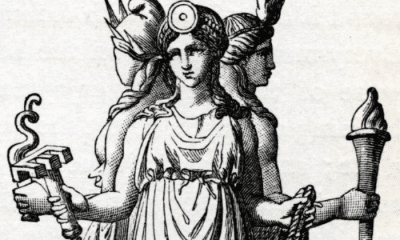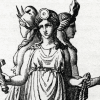Greek
How Did Poseidon Get His Trident?
Poseidon’s trident was his most prominent symbol, but how did the god of the sea get his iconic weapon?
Many of the Greek gods had attributes that were associated with them. Some were purely symbolic in art, while others played a role in the deity’s mythology as well.
Of all the attributes of the gods, few are as prominent as Poseidon’s trident. The sea god’s three-pronged spear is shown in virtually every image of him and is often featured in his legends as well.
Like many of the gods’ symbols, the trident also had a story connected to its origin. In the legend of how the gods of Olympus won power from their elders, Poseidon’s trident was a powerful gift that helped to ensure victory for the younger gods.
The story of how Poseidon got his trident in mythology is linked to the origin of the gods and their powers. In life as well, Poseidon’s trident may have ancient symbolism that gives insight into how the god of the sea came to be.
The Origins of Poseidon’s Famous Weapon
In the art of Greece and Rome, Poseidon is almost always pictured with his trident. This three-pronged spear was both his most famous attribute and his most powerful weapon.
The story of how Poseidon got his trident begins before his birth. Gaia, the Mother Earth, and Uranus had eighteen children before the gods of Olympus were ever born.
The most famous of these were the twelve Titans, who would rise to power after deposing their father. There were also three Cyclopes and the three Hecatonchieres.
These last six children were considered monstrous by Uranus, so he shut them far away where Gaia could not reach them. The imprisonment of her children was the cause of Uranus’s fall from power, as Gaia asked Cronus to attack his father in retribution.
Her support of the Titans waned, however, because Cronus failed to free the Cyclopes and Hecatonchieres. When his own son, Zeus, grew to challenge his father, Gaia supported him in turn.
Zeus freed his brothers, who had been swallowed by their father at birth so they could never threaten his rule. Poseidon and Hades joined him in the war against the Titans.
According to some accounts, the Titan War dragged on for ten years in a stalemate. Both sides were evenly matched, with the Titans being stronger but the younger gods having more wits and strategy.
Finally, Gaia told Zeus and his brothers how they could win a definitive victory. If they freed her long-imprisoned children they could defeat Cronus and the Titans for good.
The brother did as Gaia had requested and released the Cyclopes and Hecatonchieres. The six giant children of Gaia proved to be valuable allies.
The Hecatonchieres had one hundred hands apiece, which they used to lob rocks at the defending Titans. The Cyclopes, however, emerged from their prison with gifts for the gods that had freed them.
The three Cyclopes had used their time in captivity to become skilled artisans. They had crafted three powerful tools, which they gave to Zeus and his brothers.
Zeus received his iconic thunderbolts while Hades took a helmet that granted its wearer invisibility. Poseidon received his trident.
The three-pronged spear held properties that made it valuable in war. By striking the rocks at his feet with his trident, Poseidon could cause earthquakes, create springs, and bring raging floodwaters.
With these tools, the younger Olympian gods easily defeated the Titans.
Zeus and his brothers divided the realms of the world between them. While he shared the rule of the Earth and Mount Olympus with his brothers, Poseidon took control of the sea and made his home there.
Poseidon continued to use his trident. Sometimes this use was beneficial, like when he created the spring that gave Athens its water, but it could also bring devastation with earthquakes and floods.
My Modern Interpretation
The mythology of ancient Greece may have claimed that Poseidon received his trident before he took his place as the god of the sea, but the god’s tool of choice was a symbol of his domain.
Poseidon’s trident was a tool that would have been familiar to many mortal men of the ancient world in its form. The god of the sea, fittingly, used a fishing spear.
It is likely that the sea god’s iconography developed before the legend of the Titanomachy. The fishing spear was already part of his imagery and the story of the Cyclopes and their gifts was used to explain how he received it.
The Greek story of creation and the succession of the gods does not survive in its entirety but is instead reconstructed from a variety of sources. The contradiction of the gods receiving their gifts before they took corresponding realms may be a result of different sources being pieced together to create a cohesive narrative.
Some scholars believe that the Greek legends of the generations of the gods may reflect the way in which the Olympian pantheon replaced older belief systems in the region. In both legend and reality, therefore, Poseidon may have taken his realm relatively late in history.
When the first Greek-speaking people moved into the Peloponnesian region, they brought some gods with them. Their sky god, Zeus, was the chief god of this early pantheon.
Over time, they incorporated native deities into their expanding mythology. Legends were rewritten and often the gods were changed in order to fit the Greek view of the world.
It is thought that the Minoan equivalent of Poseidon was the chief male deity of their religion. When the Greeks incorporated the mythology of Crete as their own, Poseidon was recast as the sea god and many of his myths as king were transferred to Zeus.
When this happened, Poseidon was given an immediately identifiable attribute of a sea god. The fishing spear, which later took on more powerful properties, was an easy way to identify Poseidon as the god of the water.
Before the realms of the gods were delineated, it’s possible that Poseidon and Zeus both carried the same weapon. The labrys, or double-headed ax, was a pre-Greek symbol for power and authority.
Some historians have suggested that the labrys, which was used in both Minoan and Lydian iconography, was an early symbol for both king gods. As Poseidon and Zeus’s roles were separated, their weapons were changed to ones that identified them by the realm they controlled.
The symbol of the trident was also one that was not exclusive to the sea. While its resemblance to a fishing spear made it a fitting symbol for Poseidon, it also has a prominent parallel in another Indo-European religion.
In Hinduism, the trishula is a prominent symbol of power. In its form, the three-pronged spear of South Asia closely resembles that of Greece, although it is often composed of three blades rather than spear tips.
In India and South Asia, however, the trishula is not specifically linked to the sea. The war goddess Durga carries it as one of her many weapons, but it most closely linked to Shiva.
Shiva is among the chief deities of Hinduism, furthering the three-pronged spear as a symbol of power rather than specifically the sea. As the religion places a great emphasis on trinities, the trishula also has mythical and spiritual significance as a symbol of various concepts of the universe.
It seems highly possible that Poseidon’s trident and Shiva’s trishula share a common ancient symbolism. When the early Greeks created the iconography of their sea god, they used an existing model of divine power.
In Summary
Poseidon’s trident was his most recognizable attribute. In the god’s mythology, it was a tool and weapon that could create springs, bring floods, and cause earthquakes.
According to the reconstructed mythology of the Olympians’ rise to power, the trident was a gift from the Cyclopes. These three giant sons of Gaia, imprisoned by Uranus, had given Poseidon and his brothers powerful tools in their fight against the Titans.
Poseidon’s trident is usually thought to represent a fishing spear, denoting his position as the god of the sea. In mythology, however, he received his weapon before he took possession of the marine realm.
This may be due to the fact that the available tellings of the story are incomplete, but it could also be related to the ways in which the Greek gods and their iconography developed.
Poseidon is probably derived from earlier, pre-Greek religions in which he was not tied to water and the sea. As early Greek culture incorporated more gods into their faith, he was given power over the sea and acquired a symbol that resembled a fishing spear.
This resemblance, however, may be secondary. Poseidon’s trident closely resembles the trishula of South Asian religions, which in Hinduism is primarily linked to the god Shiva.
If this is the case, the trident could derive from a far more ancient symbol for divine power.



